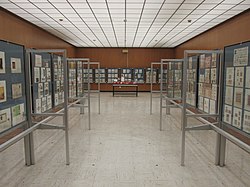Spellman Museum of Stamps & Postal History

Spellman Museum of Stamps and Postal History
|
|
| Founded | 1960 |
|---|---|
| Founder | Cardinal Francis Spellman |
| Type | not-for-profit, educational organization |
| Focus | Philately and Postal history |
| Location | |
| Origins | Cardinal Spellman and Philadelphia National Philatelic Museum stamp collections |
|
Area served
|
Worldwide |
| Product | displays, library, programs for children |
|
Members
|
400 |
|
Key people
|
Nancy B. Clark, Chairman of the Board |
|
Revenue
|
donations, grants |
| Endowment | endowment fund |
|
Employees
|
2+ |
|
Volunteers
|
21 |
| Mission | Teaching through philately |
| Website | [1] |
| Second largest philatelic museum in the United States, oldest philatelic museum in the Americas | |
The Spellman Museum of Stamps & Postal History, also commonly known as the Cardinal Spellman Philatelic Museum, is a not-for-profit organization dedicated to the appreciation of diversity through the medium of postage stamps and postal history.
The museum is located at 235 Wellesley Street, at Regis College, Weston, Massachusetts. The museum has limited hours and is open to the public on Thursdays through Sundays except in July and August when the museum is closed on Sundays. Special activities are held at the museum, and are listed in its schedule calendar.
The museum was founded in 1960, attended by a host of postal and philatelic dignitaries, and now contains over two million philatelic items, ranging from postage stamps, to postal history, to artifacts of communications through the mails. The collections that make up the museum are the personal collection of Cardinal Francis Spellman, the collections from the Philadelphia National Philatelic Museum, and collections and portions of collections donated or loaned by other collectors such as President Dwight D. Eisenhower, Musician Jascha Heifetz, and General Matthew Ridgway. Its principal mission is to engage and teach diversity, history, and geography through its philatelic exhibits, library, resource center, and programs for children.
Cardinal Spellman, around 1950, wrote:
The museum is supported by grants, donations, admission fees, an endowment fund, and other sources of donated funds.
The museum is administered by a Board of Trustees, a museum staff, a Director’s Round Table of friends it can call upon for advice and support, and a number of dedicated volunteers.
For a nominal charge, the museum will evaluate philatelic collections, and extract archived collections for private viewing. It also allows space rental of its facilities.
Coordinates: 42°20′54.5″N 71°18′25.6″W / 42.348472°N 71.307111°W
...
Wikipedia
